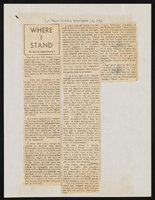Search the Special Collections and Archives Portal
Search Results

Program for the Valley View Golf Club 3rd Annual Invitational Tournament, November 1961
Date
1961-11-01
Archival Collection
Description
Program of 3rd annual golf tournament of the Valley View Golf Club held at Las Vegas Municipal Golf Course (November 1961).
Text

Correspondence, F.R. McNamee to Sadie George
Date
1917-05-24
Archival Collection
Description
This folder is from the "Correspondence" file of the Sadie and Hampton George Papers (MS-00434)
Text
Pagination
Refine my results
Content Type
Creator or Contributor
Subject
Archival Collection
Digital Project
Resource Type
Year
Material Type
Place
Language
Records Classification








